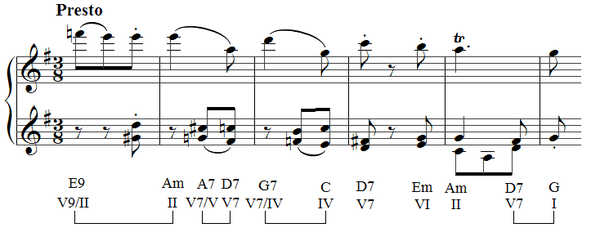Secondary dominant
|
|
Secondary dominants are a kind of chord used in musical harmony. These chords are also called applied dominants.
| Contents |
Definition and notation
The normal diatonic major scale defines six (in one view, seven) basic chords, designated with Roman numerals in ascending order. For instance, in the key of C major, the six basic chords are these:
SixBasicChordsInCMajor.PNG
Of these chords, V (G major) is said to be the dominant of C major (the dominant of any chord is the one whose root is a fifth higher). However, each of the chords from II through VI also has its own dominant. For example, VI (A minor) has the dominant of E major. These extra dominant chords are not part of the key of C major as such, because they include notes that are not part of the C major scale. Instead, they are the secondary dominants.
Below is an illustration the secondary dominant chords for C major. Each chord is accompanied by its standard number in harmonic notation. In this notation, a secondary dominant is usually labeled with the formula "V of ..."; thus "V of II" stands for the dominant of the II chord, "V of III" for the dominant of III, and so on. A shorter notation, used below, is "V/II", "V/III", etc. The secondary dominants are connected with lines to their corresponding tonic chords.
Note that of the above, V/IV is the same as I. However, as will become clear shortly, they are not always identical.
Like most chords, secondary dominants can be classified by whether they contain certain additional notes outside the basic triad; for details, see Figured bass. For present purposes, we can say that a dominant seventh chord (notation: V7) is one that contains the note that is a seventh above the root, and a dominant ninth chord (notation: V9) contains the note a ninth above the root. For instance, V7/IV, although it is a C chord, is distinct from regular C major because it also contains the note B flat, which is a minor seventh above the root of C, and not part of the C major scale.
To illustrate, here are the secondary dominants of C major, given as dominant seventh chords. They are shown leading into their respective tonics, as given in the second inversion.
SecondaryDominantSeventhChordsInCMajor.PNG
Choice of major over minor for secondary dominants
Secondary dominants are virtually always major chords, not minor; thus, the secondary dominant of VI in C major is considered to be E major, not E minor. This accords with the fact that in a minor key, it is normally the dominant major chord, not the dominant minor, that serves the function of dominant harmony.
Normal sequencing of secondary dominant chords
When used in music, a secondary dominant it is very often (though not inevitably) directly followed by the chord of which it is the dominant. Thus V/II is normally followed by II, V/VI by VI, and so on. This is similar to the general pattern of music wherein the simple chord V is often followed by I. The tonic is said to "resolve" the slight dissonance created by the dominant. Indeed, the sequence V/X + X, where X is some basic chord, is thought of by some musicians as a tiny modulation, acting as a miniature dominant-tonic sequence in the key of X.
Mozart example
In the well-known harmony textbook by Walter Piston and Mark DeVoto, a passage from the last movement of Mozart's Piano Sonata K. 283 in G major serves as one illustration of secondary dominants. Below, the harmony alone is first given, labeled both for the literal names of the chords and for their chord number in the key of G major.
HarmonicProgressionFromMozartPianoSonataK283_3rdMvt.PNG
It can be seen that this passage has three secondary dominants, each one followed (as expected) by the chord of which it is the dominant. At the end, there is a standard dominant-tonic cadence, which concludes the phrase. The lines drawn below the diagram show each instance in which a dominant is followed by its corresponding tonic.
The harmony is distributed more subtly between the notes, and goes faster, in Mozart's original:
The secondary dominants here create a rapidly descending chromatic harmony, an effective lead-up to the tonic cadence at the end of the phrase. There are many similar passages in Mozart's music.
Book
- Walter Piston and Mark DeVoto (1987) Harmony, 5th ed. New York: Norton, ISBN 0393954803.


